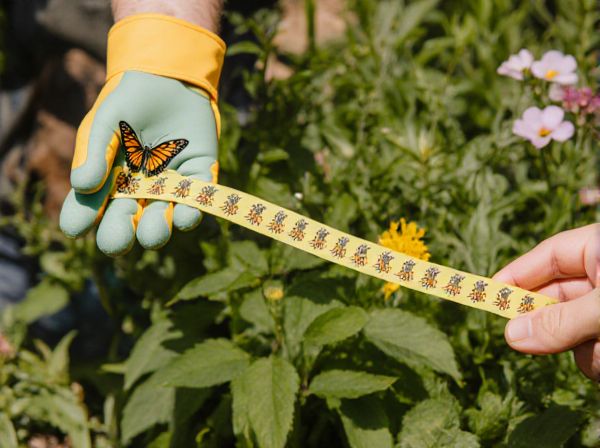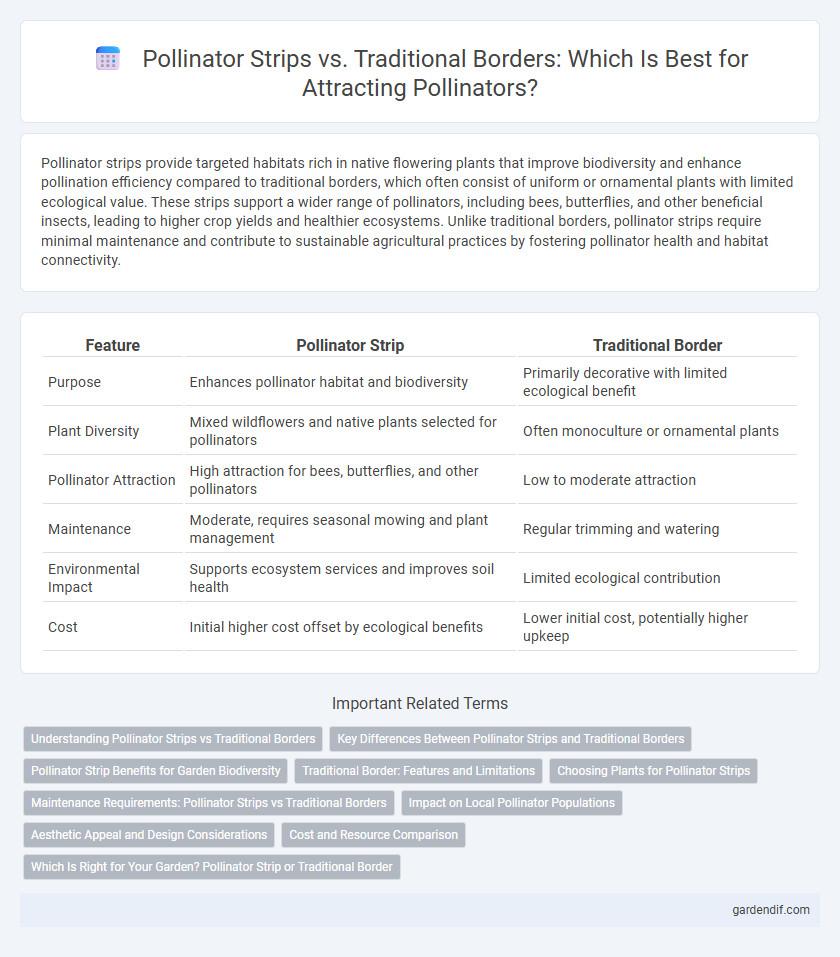
Pollinator Strip vs Traditional Border Illustration
Pollinator strips provide targeted habitats rich in native flowering plants that improve biodiversity and enhance pollination efficiency compared to traditional borders, which often consist of uniform or ornamental plants with limited ecological value. These strips support a wider range of pollinators, including bees, butterflies, and other beneficial insects, leading to higher crop yields and healthier ecosystems. Unlike traditional borders, pollinator strips require minimal maintenance and contribute to sustainable agricultural practices by fostering pollinator health and habitat connectivity.
Table of Comparison
| Feature | Pollinator Strip | Traditional Border |
|---|---|---|
| Purpose | Enhances pollinator habitat and biodiversity | Primarily decorative with limited ecological benefit |
| Plant Diversity | Mixed wildflowers and native plants selected for pollinators | Often monoculture or ornamental plants |
| Pollinator Attraction | High attraction for bees, butterflies, and other pollinators | Low to moderate attraction |
| Maintenance | Moderate, requires seasonal mowing and plant management | Regular trimming and watering |
| Environmental Impact | Supports ecosystem services and improves soil health | Limited ecological contribution |
| Cost | Initial higher cost offset by ecological benefits | Lower initial cost, potentially higher upkeep |
Understanding Pollinator Strips vs Traditional Borders
Pollinator strips are specifically designed with a diverse mix of native flowering plants that provide continuous nectar and pollen sources throughout the growing season, enhancing biodiversity and supporting pollinator health. Traditional borders often consist of ornamental plants selected for aesthetic appeal rather than ecological function, resulting in limited benefits for pollinator species. Understanding these differences highlights the superior role of pollinator strips in promoting sustainable ecosystems and improving pollination services for nearby crops.
Key Differences Between Pollinator Strips and Traditional Borders
Pollinator strips consist of dense, diverse native flowering plants specifically selected to support pollinator species such as bees, butterflies, and hummingbirds, whereas traditional borders often feature ornamental plants with limited ecological benefits. Pollinator strips prioritize continuous bloom periods and nectar sources to enhance habitat connectivity and biodiversity, contrasting with traditional borders designed primarily for aesthetic appeal without consideration for pollinator needs. The maintenance of pollinator strips involves reduced pesticide use and seasonal plant rotation to sustain pollinator populations, while traditional borders may rely on routine chemical treatments that can harm pollinator health.
Pollinator Strip Benefits for Garden Biodiversity
Pollinator strips significantly enhance garden biodiversity by providing a continuous, resource-rich habitat for bees, butterflies, and other pollinators throughout the growing season. Unlike traditional borders that often consist of ornamental plants with limited ecological value, pollinator strips incorporate native flowering species tailored to support a wide range of pollinator species, boosting ecosystem resilience and promoting natural pest control. These strips improve pollination services, leading to healthier plant populations and increased productivity in garden ecosystems.
Traditional Border: Features and Limitations
Traditional borders provide structured planting layouts with clear edge definition, often featuring ornamental plants that prioritize aesthetics over ecological function. These borders tend to support limited pollinator diversity due to uniform plant species and lack of continuous bloom periods. The rigidity of traditional borders restricts habitat complexity and foraging resources critical for sustaining diverse pollinator populations.
Choosing Plants for Pollinator Strips
Choosing plants for pollinator strips involves selecting native flowering species that bloom sequentially to provide consistent nectar and pollen sources throughout the growing season. Unlike traditional borders that may prioritize aesthetics or non-native plants, pollinator strips emphasize biodiversity with species like milkweed, coneflowers, and bee balm to support bees, butterflies, and other pollinators. Incorporating a mix of herbaceous perennials, grasses, and flowering herbs enhances habitat quality and promotes ecosystem services such as pollination and soil health.
Maintenance Requirements: Pollinator Strips vs Traditional Borders
Pollinator strips require minimal maintenance due to their use of native, drought-tolerant plants that thrive with less watering and reduced fertilizer application compared to traditional borders, which often need regular pruning, irrigation, and chemical treatments. The reduced maintenance demands of pollinator strips support sustainability by lowering labor costs and minimizing environmental impact. Traditional borders may also require frequent pest control interventions, whereas pollinator strips promote biodiversity, naturally deterring pests and reducing the need for interventions.
Impact on Local Pollinator Populations
Pollinator strips contain diverse native flowering plants that provide continuous nectar and pollen resources, significantly boosting local pollinator populations by supporting species such as bees, butterflies, and hoverflies. Unlike traditional borders, which often feature ornamental plants with limited ecological value, pollinator strips enhance habitat quality and connectivity, promoting pollinator diversity and abundance. Studies indicate pollinator strips increase both the richness and foraging activity of native pollinators, leading to improved ecosystem services like pollination of nearby crops and wild plants.
Aesthetic Appeal and Design Considerations
Pollinator strips enhance garden aesthetics by integrating vibrant, diverse native flowers that attract bees, butterflies, and other pollinators, creating dynamic seasonal interest and natural beauty. Unlike traditional borders often comprised of uniform plants, pollinator strips offer irregular shapes and mixed plant heights, promoting a more organic and visually engaging design. Careful planning ensures pollinator strips support habitat connectivity and biodiversity while complementing landscape architecture and homeowner preferences.
Cost and Resource Comparison
Pollinator strips typically require lower upfront costs and reduced maintenance compared to traditional borders, as they demand fewer inputs like fertilizers and pesticides. These strips enhance resource efficiency by providing concentrated habitats that optimize pollinator foraging without extensive landscaping or water use. Traditional borders often incur higher expenses due to diverse plant species needing ongoing care and greater resource consumption for irrigation and upkeep.
Which Is Right for Your Garden? Pollinator Strip or Traditional Border
A pollinator strip offers a targeted habitat with a diverse mix of native flowering plants, boosting pollinator activity and supporting biodiversity more effectively than a traditional border. Traditional borders often emphasize aesthetics with uniform plantings but may lack the specialized floral resources needed for sustained pollinator health. Selecting a pollinator strip is ideal for gardeners aiming to enhance ecosystem services, while traditional borders suit those prioritizing design and structure.
Pollinator Strip vs Traditional Border Infographic

 gardendif.com
gardendif.com